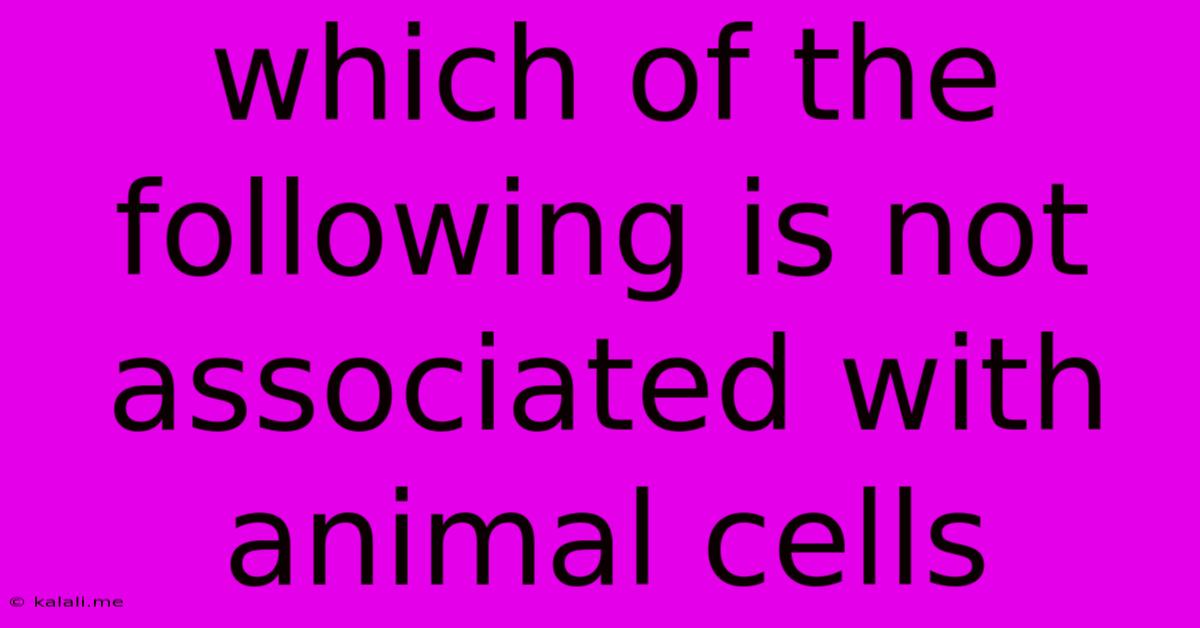Which Of The Following Is Not Associated With Animal Cells
Kalali
Jun 14, 2025 · 3 min read

Table of Contents
Which of the following is NOT associated with animal cells? A Comprehensive Guide
This article explores the key components of animal cells and identifies structures not typically found within them. Understanding the differences between plant and animal cells is crucial in biology, and this guide will help clarify the unique characteristics of each. We'll delve into the structures found in animal cells and highlight what sets them apart from other types of cells, particularly plant cells.
What are Animal Cells?
Animal cells are eukaryotic cells, meaning they possess a membrane-bound nucleus containing their genetic material (DNA). They are the fundamental building blocks of animals and are responsible for all the functions necessary for life, from respiration and reproduction to growth and movement. Unlike plant cells, they lack a rigid cell wall and chloroplasts.
Key Components of Animal Cells:
- Cell Membrane: This selectively permeable membrane encloses the cell's contents and regulates the passage of substances in and out. It's crucial for maintaining homeostasis.
- Cytoplasm: The gel-like substance filling the cell, containing various organelles.
- Nucleus: The control center of the cell, housing the DNA and directing cellular activities.
- Mitochondria: The "powerhouses" of the cell, responsible for generating energy through cellular respiration.
- Ribosomes: Sites of protein synthesis.
- Endoplasmic Reticulum (ER): A network of membranes involved in protein and lipid synthesis and transport.
- Golgi Apparatus: Processes and packages proteins for secretion or transport within the cell.
- Lysosomes: Contain enzymes that break down waste materials and cellular debris.
- Vacuoles: Storage compartments for water, nutrients, and waste products. (Note: these are generally smaller and more numerous in animal cells compared to plant cells).
- Centrioles: Involved in cell division.
Structures NOT Associated with Animal Cells:
The primary structures that distinguish animal cells from plant cells are:
- Cell Wall: A rigid outer layer providing structural support and protection, absent in animal cells. Plant cells rely on their cell walls for shape and rigidity, a feature not present in animal cells, which maintain their structure through their cytoskeleton.
- Chloroplasts: These organelles conduct photosynthesis, converting light energy into chemical energy. Animals obtain energy through consuming other organisms, hence the absence of chloroplasts in animal cells.
- Large Central Vacuole: Plant cells typically have a large central vacuole that occupies a significant portion of the cell's volume, maintaining turgor pressure and storing water and nutrients. While animal cells do have vacuoles, they are significantly smaller and less prominent.
Common Multiple Choice Question Examples:
Multiple choice questions testing knowledge of cell structures often include options like these:
- Which of the following is NOT found in animal cells?
- a) Cell membrane
- b) Mitochondria
- c) Cell wall
- d) Nucleus
The correct answer is c) Cell wall.
- Which of the following organelles is responsible for photosynthesis?
- a) Mitochondria
- b) Chloroplasts
- c) Ribosomes
- d) Golgi Apparatus
The correct answer is b) Chloroplasts (and this is why it's not found in animal cells).
In conclusion, understanding the fundamental differences between animal and plant cells, particularly the absence of a cell wall and chloroplasts in animal cells, is crucial for a strong grasp of cell biology. This knowledge forms a solid base for further studies in cellular processes and related fields.
Latest Posts
Latest Posts
-
What Is The Major Intracellular Cation
Jun 15, 2025
-
Land Where It Is Possible To Grow Crops Is Called
Jun 15, 2025
-
Which Of The Following Is Not A Characteristic Of Capitalism
Jun 15, 2025
-
Which Is Not A Step Of The Scientific Method
Jun 15, 2025
-
Whats The Square Root Of 39
Jun 15, 2025
Related Post
Thank you for visiting our website which covers about Which Of The Following Is Not Associated With Animal Cells . We hope the information provided has been useful to you. Feel free to contact us if you have any questions or need further assistance. See you next time and don't miss to bookmark.